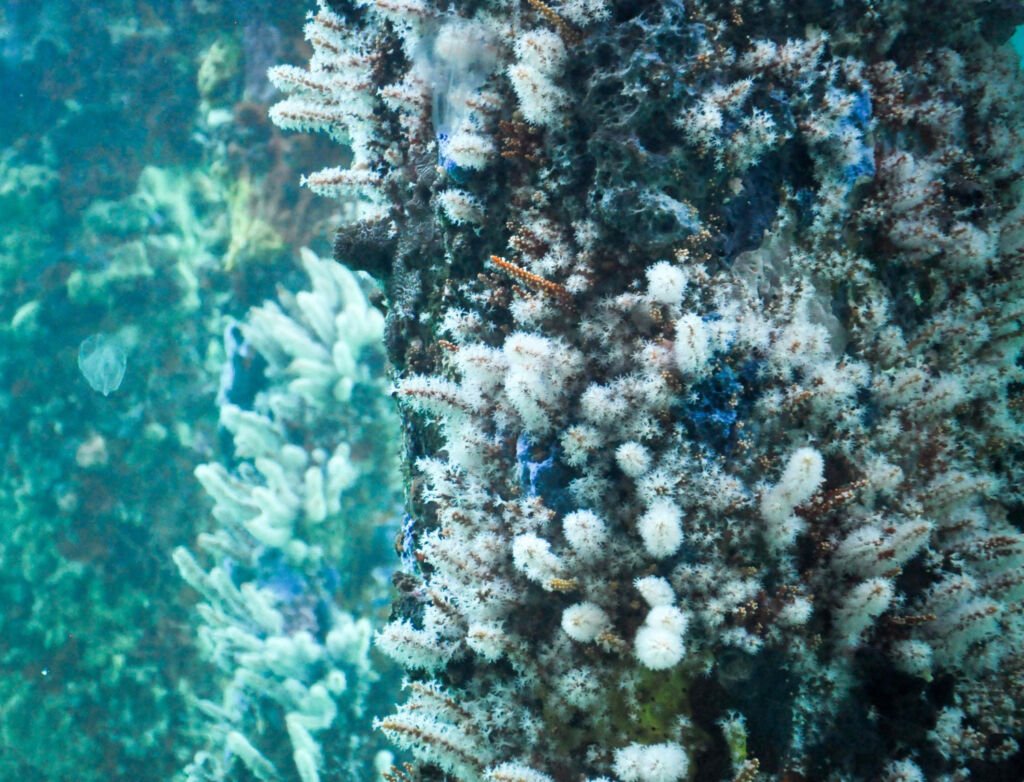Introduction:
The year 2024 will be etched into the history of our oceans – a year marked by widespread devastation. Scientists have long warned of the impending catastrophe, but 2024 has turned those warnings into harsh reality. Examples of coral bleaching in 2024 are not isolated incidents; they represent a global crisis unfolding.

Coral reefs, the vibrant heart of marine ecosystems worldwide, succumb to the stress of a warming planet. From the once-vibrant Great Barrier Reef to the crystal-clear waters of the Caribbean, they are turning ghostly white in a desperate response to rising ocean temperatures.
This is not a distant problem confined to faraway reefs; the consequences of coral bleaching will ripple through marine ecosystems and coastal communities worldwide. Examples of coral bleaching in 2024 paint a stark picture of the impacts of climate change and inaction and demand a global response.
What are Corals?
While they might look like colorful rocks or plants, corals are marine invertebrates in the same group as jellyfish and sea anemones (phylum Cnidaria).
An individual coral is called a polyp. These are tiny, soft-bodied creatures with a simple structure – a stomach and mouth surrounded by stinging tentacles.
Corals live in colonies made of hundreds to thousands of genetically identical polyps. It’s these colonies that create the magnificent reef structures we see.
Stony corals, the main reef-builders, secrete a hard calcium carbonate exoskeleton. Over time, layers of these skeletons form the foundation of coral reefs.
Corals have a symbiotic relationship with microscopic algae called zooxanthellae. These algae live within coral tissue and give corals their vibrant colors. They also provide corals with energy through photosynthesis.
Importance of Corals and Coral Reefs:
Coral reefs are the “rainforests of the sea.” They support 25% of all marine life despite covering less than 1% of the ocean floor. This biodiversity is vital for a healthy ocean ecosystem.
Coral reefs are essential breeding grounds and nurseries for numerous fish species we rely on for food. Healthy reefs sustain both commercial and subsistence fishing industries around the world.
Compounds derived from coral reef organisms have led to the development of medications for cancer, arthritis, bacterial infections, and other diseases. They hold immense potential for further medical discoveries.
The complex structure of reefs absorbs wave energy, protecting shorelines from erosion and storm surges. This protects coastal homes, infrastructure, and agricultural land.
The beauty of coral reefs attracts millions of divers, snorkelers, and tourists worldwide. This generates significant revenue for coastal communities and national economies.
Reef-dependent tourism supports many jobs, from dive instructors and tour operators to hotel and restaurant workers.
Corals have been around for millions of years. Fossil corals can help us understand past climates and ocean conditions.
Some corals are biofluorescent species, meaning they glow in spectacular colors under certain light conditions!
What is Coral Bleaching?
Corals are vital to the ocean ecosystem, providing habitat for countless species and protecting coastlines. However, under stress, corals expel the colorful algae living within them, turning stark white – a phenomenon known as coral bleaching.
Causes of Coral Bleaching:
The following factors often combine to create conditions ripe for coral bleaching. For example, a coral reef already stressed by ocean acidification is far more vulnerable to bleaching during warm water temperatures.
Rising Ocean Temperatures Due to Climate Change: This is the most significant cause of coral bleaching. As greenhouse gas emissions lead to global warming, ocean waters absorb excess heat, leading to prolonged periods of above-average temperatures. Even a slight temperature rise can make corals expel their algae. Examples of coral bleaching in 2024 starkly illustrate the consequences of unchecked climate change.
El Niño Events: These cyclical climate patterns can lead to periods of abnormally warm ocean temperatures, further stressing coral reefs. The prolonged El Niño event of 2023 is believed to contribute to the widespread examples of coral bleaching in 2024.
Ocean Acidification: Ocean acidification, caused by the oceans absorbing excess carbon dioxide (CO2) from the atmosphere, poses a significant threat to corals. This process alters seawater chemistry, making it more difficult for corals to build their essential calcium carbonate skeletons. Weakened corals are far more vulnerable to the stress of other factors, leading to the concerning examples of coral bleaching in 2024.

Pollution and Runoff: Fertilizers, sewage, and other pollutants from land can reach coral reefs, disrupting the delicate balance of the ecosystem. These pollutants can also cause harmful algal blooms that block sunlight, vital for the coral’s symbiotic algae.
Extreme Low Tides: When tides are exceptionally low, shallow water corals can be exposed to air and too much sunlight, leading to bleaching.
Overexposure to Sunlight: Prolonged periods of intense sunlight, particularly when combined with high water temperatures, can cause bleaching in corals.
Consequences of Coral Bleaching:
Ecological Consequences:
Collapse of Reef Ecosystems: When large corals die due to bleaching, the intricate food webs and relationships they support crumble. Fish populations decline, algae can overgrow the reefs, and overall biodiversity plummets.
Reduced Reproductive Success: Even if corals survive bleaching, the stress impairs their ability to reproduce, making it harder for reefs to recover and replenish themselves.
Increased Vulnerability to Disease: Bleached corals are more susceptible to diseases, compromising their health and potential for survival.
Economic Consequences:
Fisheries Decline: Fish that rely on coral reefs for food and shelter will dwindle, impacting commercial and subsistence fishers who depend on them for their livelihoods.
Tourism Losses: Degraded, bleached reefs lose their vibrant appeal, leading to a decline in tourism revenue and hurting local economies that rely on healthy reefs.
Coastal Infrastructure Damage: Without the protective barrier of reefs, coastlines become more vulnerable to storms and erosion, leading to costly damage to property and infrastructure.
Social and Cultural Consequences:
Food Security Threatened: Coastal communities that depend on reefs for their primary source of protein face food insecurity as fish populations decline due to bleaching.
Loss of Cultural Heritage: For many coastal cultures, reefs are deeply intertwined with their identity and traditions. The decline of reefs represents a loss of cultural heritage and traditional ways of life.
These consequences are often interconnected. For instance, the decline of fisheries can lead to economic hardship, which limits resources available for reef conservation, further exacerbating the problem.
Examples of Coral Bleaching in 2024:
The Great Barrier Reef Bleaching, Australia:
The Great Barrier Reef, the world’s largest coral reef ecosystem, is tragically experiencing the devastating effects of climate change and coral bleaching. Bleaching events have occupied every area of the Great Barrier Reef (GBR) in recent years. However, some regions are more severely impacted than others.
- Northern GBR: This section has suffered the most severe and repeated bleaching events, leading to significant coral mortality.
- Central GBR: This area has also experienced considerable bleaching, with varying coral loss across reefs.
- Southern GBR: Bleaching has been less extensive in the southern region, but it’s increasingly affected by each warming event.

Primary Reason for Coral Bleaching in the GBR:
While other factors can contribute to localized coral bleaching on the GBR, such as pollution or extreme low tides, climate change-driven ocean warming is the overarching threat pushing the reef system towards a critical tipping point.
- Greenhouse gas emissions: Human activities, particularly the burning of fossil fuels, release excess greenhouse gases into the atmosphere. These gases trap heat, causing the planet and its oceans to warm.
- Increasingly frequent and severe heatwaves: The Great Barrier Reef has been particularly susceptible to marine heatwaves prolonged periods of abnormally high ocean temperatures. These heatwaves are becoming more frequent and severe due to climate change.
- Coral sensitivity: Even a slight increase in ocean temperatures (as little as 1-2 degrees Celsius above average) for several weeks can stress corals enough to cause bleaching.
Efforts to Monitor and Potentially Mitigate the Damage:
The fate of the Great Barrier Reef hangs in the balance. While efforts are underway, whether they will be enough to help the reef survive under the ever-increasing stress of climate change remains a critical and urgent question.
The sheer scale of the Great Barrier Reef demands a multi-pronged and collaborative approach. Large organizations like the Australian Institute of Marine Science (AIMS) and the Great Barrier Reef Marine Park Authority (GBRMPA) lead the efforts, working with universities, citizen scientists, and the reef tourism industry.
- Extensive Monitoring: Scientists regularly conduct aerial and underwater surveys to track the extent and severity of bleaching on the GBR. This data is vital for understanding the changing state of the reef.
- Restoration Initiatives: Research is underway exploring ways to improve coral resilience and restore degraded reefs. This includes out-planting heat-tolerant corals, artificial reef structures, and techniques to facilitate natural larval settlement.
- Addressing Climate Change: While local conservation is crucial, scientists emphasize that the most effective way to save the GBR is to curb greenhouse gas emissions that drive ocean warming drastically.
- Water Quality Initiatives: Localized efforts focus on reducing pollution and runoff onto the reef; this helps improve conditions and may give weakened corals a slightly better chance of recovery.
- Long-term Monitoring: Programs like the Australian Institute of Marine Science’s (AIMS) Long-Term Monitoring Program track reef health over decades. This long-range data is critical for understanding shifting baselines and the cumulative effects of bleaching events.
- Cloud Brightening: Experimental trials explore ‘cloud brightening’ – spraying fine seawater mist into the air to form more reflective clouds. These could potentially provide localized shading and reduce thermal stress on vulnerable reefs.
The Coral Bleaching in the Caribbeans:
Sadly, 2024 is emerging as another devastating year for Caribbean corals. Bleaching events of unprecedented severity are sweeping across the region, signaling a dire situation for these already vulnerable ecosystems.
Record-breaking Bleaching Severity:
Scientists are witnessing a scale of coral bleaching surpassing previous events, with worrying levels of coral mortality. The warm waters causing this bleaching are a disturbing trend linked to climate change.
Specific Locations Severely Impacted:
- Florida Keys: The iconic reefs of the Florida Keys are experiencing widespread bleaching, putting this popular tourism destination and its ecosystem at risk.
- The Bahamas: This island nation, heavily reliant on reef-based tourism, faces extensive bleaching throughout its diverse coral systems.
- Lesser Antilles: Islands across the Lesser Antilles chain report severe bleaching on their reefs, impacting their marine life and coastal communities.

The Compounding Effects of Pollution and Overfishing:
Caribbean reefs face coastal pollution, land-based runoff, and overfishing stresses. These factors weaken corals, making them even more prone to bleaching during heat events.
Pollution can hinder a coral’s recovery after bleaching, while overfishing removes key species that help keep reefs healthy and maintain balance. This combined pressure makes the outlook for Caribbean reefs in the wake of 2024’s bleaching events especially concerning.
Main Reason for Coral Bleaching in the Caribbean:
The leading cause of Caribbean coral bleaching is the same culprit responsible for bleaching events globally: rising ocean temperatures due to climate change.
- Climate Change and Ocean Warming: Greenhouse gas emissions from human activities trap heat, warming the planet and oceans. Even a slight rise in ocean temperature for sustained periods can trigger widespread coral bleaching events.
- Marine Heatwaves: Like many other regions, the Caribbean is particularly vulnerable to marine heatwaves. These periods of abnormally high temperatures are becoming more frequent and intense due to climate change, pushing corals beyond their thermal tolerance.
- El Niño Influence: El Niño events, a cyclical climate pattern, can further exacerbate warming trends in the Caribbean, increasing the likelihood of severe bleaching events.
Efforts to Monitor and Potentially Mitigate the Damage:
The Caribbean presents unique challenges due to the large number of island nations and regional variation in reef health and management resources. Efforts tailored to increasing collaboration, data sharing, and developing practical solutions that can be scaled across the region are vital.
- Bleaching Surveys: Scientists and marine organizations use various survey methods (aerial surveys, in-water assessments, and satellite monitoring) to document the extent and severity of bleaching episodes throughout the Caribbean. This data informs response and conservation efforts.
- Community Reporting: Citizen-science projects encourage coastal communities, divers, and tour operators to report bleaching observations. This can provide localized data and help identify emerging bleaching hotspots.
- Early Warning Systems: Some research is focused on developing predictive tools that use temperature and oceanographic data to forecast the likelihood of bleaching events, allowing for a more proactive response.
- Regional Networks: Organizations like the Atlantic and Gulf Rapid Reef Assessment (AGRRA) and the Global Coral Reef Monitoring Network (GCRMN) work to coordinate bleaching surveys and data collection throughout the Caribbean. This standardized approach provides a broader picture of bleaching patterns across the region.
- Mapping Thermal Stress: Projects use satellite data and sea surface temperature modeling to map areas of high thermal stress across the Caribbean. This helps predict where bleaching is most likely to occur, allowing for a more targeted response.
- Focus on Resilience: Some monitoring efforts precisely assess the differences in bleaching responses between coral species and reefs. Identifying pockets of resilience (where corals are more resistant) helps target conservation efforts.
- Super Corals: Researchers are working to identify and breed coral genotypes more tolerant of warm temperatures. These “super corals” could be used in restoration projects to boost the resilience of reefs.
- Assisted Evolution: This field explores techniques like selective breeding and potential genetic manipulation to create hardier, more heat-tolerant coral strains. While controversial, this research is happening with specific Caribbean coral species.
- Shading and Cooling: Localized, experimental efforts include shading structures to reduce direct sunlight on stressed corals during heat events. Projects also explore pumping cooler water from deeper areas to mitigate heat stress in targeted zones.
- Marine Protected Area (MPA) Expansion: Establishing and effectively managing more MPAs across the Caribbean is crucial. Well-protected reefs have a better chance of surviving and recovering from bleaching events.
The Indian Ocean Coral Bleaching:
Historically, the Indian Ocean has been less severely impacted by mass coral bleaching events than regions like the Caribbean. However, a worrying shift is underway, with corals across this vast ocean experiencing increasing stress from warming waters.
Emerging Bleaching Hotspots:
The Indian Ocean is a crucial reminder that coral bleaching is a rapidly expanding global crisis. The economic and ecological consequences for these island nations and coastal communities in the Indian Ocean are particularly severe.
Western Indian Ocean: Countries along East Africa and islands like Madagascar are reporting increasing bleaching episodes, raising alarm about reef health in this previously less impacted region.
Lakshadweep Islands: India’s Lakshadweep Islands, known for their coral diversity, have suffered recurring bleaching events in recent years, causing significant damage.
The Chagos Archipelago: Once considered a refuge due to its isolation, it has recently experienced severe bleaching, highlighting that even remote reefs are not immune.
Bleaching in the Maldives, Seychelles, and Other Island Nations:
- The Maldives, a nation heavily reliant on tourism tied to healthy reefs, has faced devastating bleaching events. The iconic reefs of this archipelago are sadly showing signs of severe decline.
- The Seychelles, another popular diving and ecotourism destination, is witnessing an alarming rise in bleaching frequency, threatening its vital reefs.

Numerous smaller island nations throughout the Indian Ocean depend on coral reefs for vibrant marine ecosystems, coastal protection, and tourism revenue. Bleaching threatens the very foundation of these nations’ economies.
Main Reason for Coral Bleaching in the Indian Ocean:
The main reason for coral bleaching in the Indian Ocean, just like most other regions, is rising ocean temperatures caused by climate change.
- Climate Change and Warming Oceans: Greenhouse gas emissions from human activities trap heat in the atmosphere, leading to a warming planet and oceans. Even a slight rise in ocean temperature for extended periods can trigger coral bleaching in the Indian Ocean.
- Variability in Warming: The Indian Ocean experiences natural temperature fluctuations due to factors like the monsoons. However, climate change is causing the baseline temperature to rise, pushing the ocean closer to bleaching thresholds.
- Marine Heatwaves: Like other regions, the Indian Ocean is susceptible to marine heatwaves – periods of abnormally high water temperatures. These events, intensified by climate change, can be particularly damaging and lead to widespread bleaching.
Efforts to Monitor and Potentially Mitigate the Damage:
The Indian Ocean’s coral reefs face a growing threat from bleaching, prompting a range of initiatives focused on monitoring and potential mitigation –
- Regional Collaboration: Organizations like the Indian Ocean Commission (IOC) and CORDIO (Coral Reefs of the Indian Ocean) are crucial for coordinating monitoring efforts across diverse member nations. This ensures standardized data collection and a broader picture of bleaching patterns.
- Satellite Monitoring: Advanced satellite technology tracks sea surface temperatures and identifies areas at risk of bleaching. Early detection allows for targeted interventions and outreach to local communities.
- Community-Based Monitoring: Programs engage local anglers and divers in data collection, allowing for real-time observations and reports on reef health. This can be particularly valuable in remote areas.
- Genetic Diversity Mapping: Researchers are mapping the genetic diversity of coral populations across the Indian Ocean. Identifying heat-tolerant coral strains naturally can inform future restoration efforts.
- Marine Protected Areas (MPAs): Expanding and effectively managing MPAs is a key strategy. Healthy, well-protected reefs are more resilient to bleaching events and can act as sources of coral larvae for repopulation.
- Coral Reef Restoration: Pilot projects are underway exploring techniques like coral gardening – cultivating coral fragments in protected nurseries and then transplanting them onto degraded reefs.
- Reducing Land-Based Pollution: Measures to control coastal runoff from agriculture and development projects can improve water quality, reduce stress on corals, and aid in recovery.
- Mangrove Conservation: Mangrove forests provide a natural buffer zone between land and sea, filtering pollutants and protecting coastlines. Protecting and restoring these ecosystems can indirectly benefit coral reefs.
- Raising Awareness: Educational programs and community outreach aim to raise awareness about the threats coral reefs face and the importance of conservation. Informed communities are more likely to participate in sustainable practices.
Conclusion:
The year 2024 stands as a stark reminder of the consequences of inaction. The examples of coral bleaching in 2024, from the Great Barrier Reef to the Caribbean, underscore the urgent need for global cooperation. While localized conservation and restoration efforts are essential, they are merely a bandage on a rapidly festering wound. The fate of the world’s coral reefs lies in addressing the root cause: climate change.

The examples of coral bleaching in 2024 cannot be seen as isolated incidents; they are a clarion call for decisive action to reduce greenhouse gas emissions and transition towards a sustainable future. It’s a call that will only grow louder unless we drastically alter our course.

